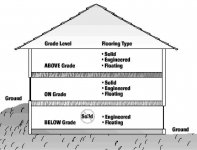sparkync
Senior Member
- Location
- North Carolina
Is there anywhere in the code that defines "ground level" for "accessory buildings"? I have a customer whose floor level in his accessory building is 18" above ground.
Is this considered "ground level", and will it require "GFCI" outlets? Thanks
Is this considered "ground level", and will it require "GFCI" outlets? Thanks

